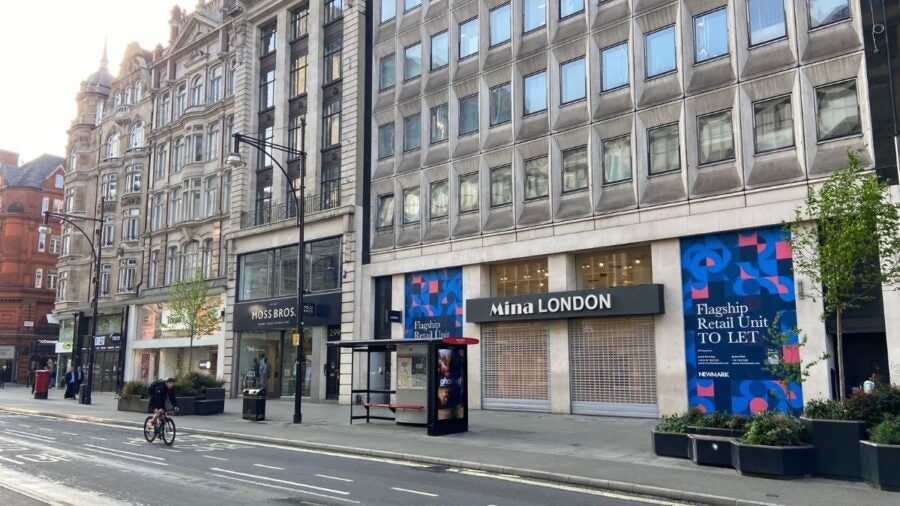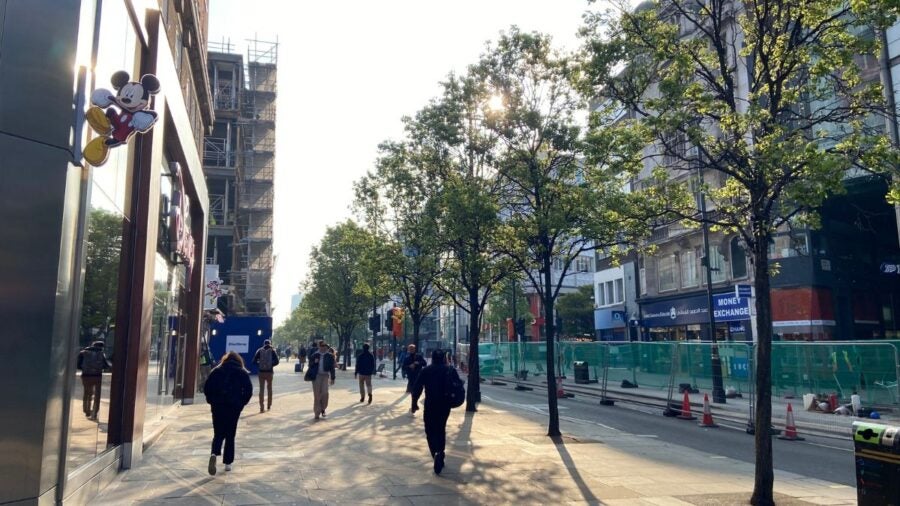
“National embarrassment” were just some of the choice words used by Marks & Spencer’s chief executive Stuart Machin to describe the current state of Oxford Street.
Once regarded as London’s premier shopping destination, the street has struggled as shops close and footfall fails to hit its pre-pandemic heights. The disappearance of some big brands, including TopShop, Adidas and Russell & Bromley, has led to a proliferation of low-level retailers and “tacky candy stores”, as Machin describes them.
The high street’s struggles are epitomised by data from the Local Data Company and Retail Week showing that 42 of Oxford Street’s 269 stores – or almost 16% – stand vacant. That leaves it with a higher percentage of empty shops than the average both for high streets in London (13%) and across Britain (14%).
Oxford Street in particular, says PwC’s senior retail advisor Kien Tan, has had a “really tough time recently”. This is due to a combination of factors, he explains, from disruption caused by the construction of Crossrail, to the reduced numbers of people coming into central London and a decline in tourist numbers – a result of the delayed reopening of many Asian countries post-Covid.
The government’s decision to abolish VAT-free shopping for tourists, which meant purchases were 20% cheaper for international visitors in October 2022 has also had a disproportionate impact on Oxford Street. “A lot of big-spending tourists who were coming to London specifically to buy expensive items, like watches or handbags, will now choose to go to Paris or somewhere else instead,” Tan adds.
Oxford Street’s struggles are reflected in the latest footfall figures. Although it welcomed an average of 1.24 million people each month last year, this figure is still 59% below its pre-pandemic baseline, according to data from MyTraffic’s European high street ranking. When comparing this to other popular European shopping destinations, the only street that performs worse is the Rue Neuve in Brussels.
Shifting consumer habits are partly to blame. Many consumers turned to online shopping during the pandemic and although there has been a gradual return to in-store purchasing, it has not returned to pre-Covid levels. Figures from the Office for National Statistics show that 25.8% of UK retail sales were made online in March, compared to 19.1% pre-pandemic.
Similarly the administrations of a number of notable high-street brands – including Topshop and Debenhams – have contributed to the increased vacancy rate in Oxford Street. Many of these stores still stand empty today or, in some instances, have been replaced by the American candy stores that are so disliked by the M&S boss.
Tan puts this down to the number of landlords that Oxford Street has compared to the neighbouring Regent Street, which is mostly owned by the Crown Estate. A single landlord can take more of a curatorial approach to the businesses it chooses to lease to, whereas Oxford Street landlords have much less of a say over which retailers move into other vacant premises. “Sweet shops are the most obvious examples of this, but many operators will sublet for a short period of time, because it helps pay the rent,” he adds.
However, Dee Corsi, chief executive of New West End Company, the business partnership that represents London’s west end traders, suggests that the number of void units are a “short-term side effect” of redevelopment. “Only short-term leases are available while developers wait for planning permission and therefore they do not appeal to major occupiers,” she adds. “The total number of void units being quoted in the media is also misleading as it includes regular vacant units and units under long-term development, as well as empty units that have already been pre-let.”
Is the British high street still in decline?
Is the decline of Oxford Street symptomatic of wider retail trends? Research from PwC shows some positive signs for the British high street. The total number of store closures in the UK has dropped from 17,219, in 2021 to 11,530 last year. Shop openings were also up slightly from 7,160 to 7,903. This brings the net change down to -3,627 shops, compared to the -10,509 of the previous year.
Rather than being in a state of decline, as many people thought would happen post-pandemic, Tan now believes the high street is going through a transition. “There’s been a rebalancing as people who were forced to go online over the pandemic are now coming back into shops,” he says. “That’s given a bit of a stay of execution for some retailers and is part of the reason why there were a lot fewer closures last year.”
Some major high street brands are also performing better following the disruption of the pandemic. Next, often considered a bellwether for the British retail sector, was able to up its profit guidance after posting better-than-expected Christmas trading figures, whereas online fashion outlet Asos saw its sales numbers drop 3% in the same period. This can be seen as evidence of the pent-up demand from consumers for the in-store shopping experience.
Whether that demand is on high streets, though, is unclear. Next and Marks & Spencer are shifting stores from town centres and high streets to purpose-built or out-of-town retail parks where there is more space and parking, shops are often open longer, and rates are lower.
Meanwhile, online sales continue to rise, boosted by the convenience and ability to easily shop for deals.
What does the future hold for Oxford Street?
Back on Oxford Street, Corsi believes the area is going through a “once-in-a-lifetime” transformation. “In five years’ time, it will be a very different place,” she predicts.
Change is already happening at pace: Ikea is opening a store in the old Topshop site later this year, The Fragrance Shop hopes to open a 2,300 sq ft experiential flagship and HMV is set to return to its Oxford Street store, which it vacated four years ago.

HMV’s unexpected move back to its old site will see it oust the candy store that replaced it and was described by Westminster Councillor Geoff Barraclough as “proof that there is a buzz back in the West End”.
The April review of business rates has also helped, with the changes meaning the average Oxford Street bill will fall by more than 30%. Corsi says that this move “will increase the appetite for units and squeeze out the low-level retail”.
She also points to the “flurry” of new leisure outlet openings, including digital exhibition space Outernet, the Twist Museum and Boom Battle Bar, as signs that Oxford Street still has something new to offer visitors.
Another positive is the fact that, contrary to popular belief, young people still enjoy physical shopping. Some 38% of 18- to 24-year-olds, surveyed by PWC, said they enjoyed in-store shopping – slightly more than the average for the UK adult population of 37%.
With year-on-year national high-street footfall declining by 7.7%, the question now facing retailers is how to make each visit more profitable. “The high street doesn’t need as many visitors if those that are going are spending more while they’re there,” Tan says.
If high-street shops can find the answer to this conundrum, there may still be a positive future for the retailers on Oxford Street and beyond.

"National embarrassment” were just some of the choice words used by Marks & Spencer’s chief executive Stuart Machin to describe the current state of Oxford Street.
Once regarded as London’s premier shopping destination, the street has struggled as shops close and footfall fails to hit its pre-pandemic heights. The disappearance of some big brands, including TopShop, Adidas and Russell & Bromley, has led to a proliferation of low-level retailers and “tacky candy stores”, as Machin describes them.
The high street’s struggles are epitomised by data from the Local Data Company and Retail Week showing that 42 of Oxford Street’s 269 stores – or almost 16% – stand vacant. That leaves it with a higher percentage of empty shops than the average both for high streets in London (13%) and across Britain (14%).
